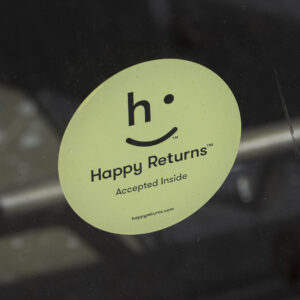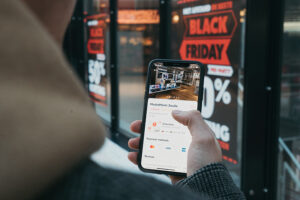Six Ways Your Point of Sale Can Make Your Holidays Happier
The holidays are here, and retailers are prepped and ready. Inventory is purchased, sales are planned, staff is reinforced, and decorations are waiting to be displayed. Even with all the planning finished, there are several ways a store’s point-of-sale system (POS) can make a retailer’s holiday happier, easier and more profitable.
Properly utilized, a point-of-sale system lets stores do more with less labor and effort, which is significant at a time when reliable employees are hard to find and business is hopping. This will be important this holiday season with the Deloitte holiday survey predicting spending to surpass pre-pandemic figures ($1,652 per shopper) for the first time. The survey also shows that 37% of shoppers’ budget is targeted for in-store shopping, the highest mark since 2019 (36%).
Here are a few ways a POS system can make the holidays better for stores and their customers.
1.) DASHING THROUGH THE CHECKOUT LINE
Did you know that U.S. consumers spend roughly 37 billion hours each year waiting in line for service? A study started in 2022 to discover how consumers felt about customer service found that almost 70% of shoppers felt bored, annoyed, frustrated, or impatient when forced to stand in line for lengthy periods.
When customers express these kinds of feelings about a store, they’re less likely to return the next time they’re shopping. That’s why fast, efficient checkout is crucial.
The best way to cut down checkout wait time is to have a POS system that is easy to use.
“A system with a user-friendly interface makes it easy for anyone, even those apprehensive about using a computer, to become productive after minimal training,” says Dan Nesmith, founder and president of Paladin Data Corporation, a leading provider of retail technology solutions for independent businesses.
Another way to cut wait times is to arm sales associates with mobile point-of-sale (MPOS) devices. Comprehensive point-of-sale software works with mobile devices that let customers make debit or credit card purchases just about anywhere.
2.) THE MOST WONDERFUL SALE OF THE YEAR
What would the holidays be without sales? From Black Friday to Super Saturday to the post-holiday clearances, retailers know the best way to bring shoppers to their stores is by offering and advertising deep discounts. And since online retailers are now holding events in October, those sales come even earlier than the traditional post-Thanksgiving retail gluttony.
Some point-of-sale systems allow retailers to create sales and set their parameters long before they occur. They can create sale lists, which contain products, classes of products, or entire departments, that can be scheduled to start and end on established dates.
“It’s great because you don’t have to babysit it. You can set it up far in advance,” says Paladin Chief Experience Officer Charles Owen. “You can make sure inventory purchased for the holidays is sold by the end of the calendar year or by the timeframe you set. That helps you manage that inventory you purchased for the holidays.”
POS systems can also create signs that go with your sale. Probably more than any other time of the year, the holidays are the perfect time to set up cascading sales – sales that offer progressively bigger discounts as the days pass.
3.) IT’S BEGINNING TO LOOK A LOT LIKE CHRISTMAS

For decades consumers groaned as the holiday shopping season crept farther and farther forward on the calendar. It wasn’t long ago when they had to wait for Black Friday to take advantage of discounts. Next, many of the larger retailers intruded even further by staying open on Turkey Day.
Now, leave it to Amazon to hold its Prime Days in October, which moves holiday shopping even further from the actual holiday. The result is that half – yes, one in every two – of shoppers will begin Christmas shopping before Halloween. That means stores of all sizes need to join that trend to avoid missing out on a sizable number of sales.
Constant Contact, the online marketing firm, lists Early Bird sales or offers as its No. 1 holiday promotion that will help stores sell more. As mentioned above, those sales should probably start around mid-October to attract premature holiday shoppers.
Holiday shopping guides, much smaller versions of the old Sears and Montgomery Ward Christmas catalogs, are becoming popular again. They can be printed at a substantial cost or be a digital publication that can be posted on a store’s website or sent via email.
Another way to spark holiday shoppers is to dress up websites with holiday images and signage. In stores, holiday spins can be put on video monitors through providers like EZ-Ad. The company links in-store video monitors and mobile POS devices to a store’s point of sale to display content such as product videos, sales information, and more. It can increase sales by improving a store’s shopping experience.
Promoting gift cards is another way to secure sales before the actual holiday season arrives. The National Retail Federation reports that 56% of consumers hope to receive gift cards for the holidays. They are a very safe way to guarantee a gift recipient gets something they really want.
4.) ALL I WANT FOR CHRISTMAS ARE REWARDS
 Everybody loves a deal, whether it’s your regular customers or locals who might rarely shop at your store. And the holidays are a perfect time to reward your loyal customers and lure in those occasional shoppers.
Everybody loves a deal, whether it’s your regular customers or locals who might rarely shop at your store. And the holidays are a perfect time to reward your loyal customers and lure in those occasional shoppers.
Stores that already have a customer incentive or rewards program can communicate added incentives to members through targeted emails, texts, or direct mail. Offering additional rewards – buy one, get one, percentage-off coupons, or double points – can be added Christmas gifts for members.
Those same kinds of sales can be offered to shoppers who sign up for a rewards program. Those bonuses can be advertised through a store’s social media feed, or regular advertising fliers. And those who sign up can pad a store’s email marketing program for post-holiday campaigns.
“Rewards programs are an incredibly important tool in customer retention. All the big-box retailers and most of the major brands offer loyalty programs. For merchants without access to these programs, companies that provide point-of-sale systems and business management services offer solutions that give retailers the same customer loyalty program features as the chain stores,” Nesmith says.
Ben Honeycutt, owner of Oak Knolls Hardware in Orcutt, California, uses the customer management functions in his Paladin point-of-sale system to power his incentive program.
“I look at my customer listings and rankings. I find out who my best customers are. Last year, we bought some nice gifts and sent them out at the holidays,” he explains, adding that unexpected gifts like that go a long way in building loyalty and retaining customers.
5.) MANY HAPPY RETURNS
 In 2022, U.S. consumers returned $613.94 billion worth of retail purchases, which represented almost 9% of total sales. That means if you’re in the business of selling products, you better be ready, willing and able to take them back.
In 2022, U.S. consumers returned $613.94 billion worth of retail purchases, which represented almost 9% of total sales. That means if you’re in the business of selling products, you better be ready, willing and able to take them back.
Having a fast, simple and seamless return policy is crucial in building good customer relations.
A store’s return policy needs to be clear, easy to understand for both customers and staff, and effectively communicated.
The effectively communicated portion of the solution is simple. It needs to be posted at every checkout counter and, with the help of a point-of-sale provider, printed on every receipt. Putting it on receipts automatically eliminates potential conflicts. Also, if payment cards – debit or credit – are used in the transaction, customers don’t even need a receipt to return an item because their transaction history is recorded in the point-of-sale system.
“With a POS system, the cool thing is you don’t have to have a receipt to get a refund. If a customer is in your system, all their sales history is recorded. If a customer isn’t in your system, you ask for a driver’s license, scan it, and, boom, they’re in your system and you have a relationship with them. You want to make returns as stress-free as possible for the consumer. That’s the kind of experience you want your stores to have with consumers. You give them that personal touch. You want to have that personal relationship with them,” Owen explains.
6.) POST-HOLIDAY PLAN
The experience your customers have during their holiday shopping excursions will often determine if they become regular customers. Like Owen says, “You want to have that personal relationship with them.”
The holidays are a great time to collect customer information. Signing shoppers up for either a rewards program or a holiday giveaway can provide a wealth of information that can be used to farm new customers. Entered into a customer database on a point-of-sale, that information can easily be turned into marketing emails, texts, or direct mail feelers.
“The actions taken in your stores every day drive customer retention,” Nesmith says. “Customer retention and increased ticket totals will drive increased customer counts which will drive increase revenues.”
brian bullock
Author



